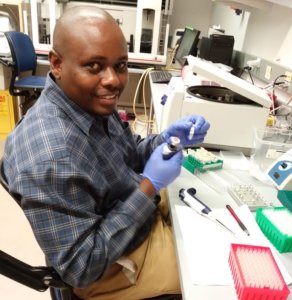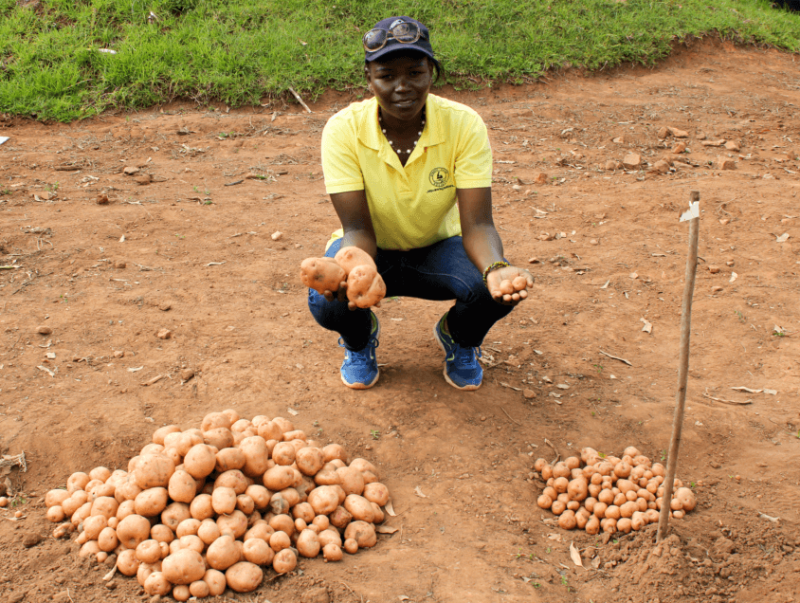Since the onset of his career, Magembe, a research scientist with the International Potato Center (CIP), has been curious to see how science can be translated into solutions.
He’s now putting that curiosity to practical purposes in his pioneering research at Biosciences eastern and central Africa (BecA) — the International Livestock Research Institute hub on the outskirts of Nairobi.
The Irish potato is an increasingly critical food source in Kenya, ranking as the second most important crop. Yet a 2004 survey of 227 farmers in Kenya revealed that 54 percent of them lost 30 to 60 percent of their yield to late blight disease (LBD). This is similar to the losses suffered in Uganda, which range from 30 to 57 percent, according to Magembe.
The average potato yields in sub-Saharan Africa are four times lower than those in industrialized nations, mostly due to the effects of diseases, particularly late blight.
Currently, farmers must spray expensive and toxic fungicides up to 15 times a season to protect crops from LBD, a cost that puts resource-poor small-scale farmers at great disadvantage. As a result, some of them suffer 100 crop loss. Cultivating LBD-resistant potatoes could increase family farm incomes by 40 percent and ensure a supply of fungicide-free potatoes to consumers.
According to Magembe, results from field trials conducted by the National Agricultural Organization (NARO) in Uganda showed that bioengineered (genetically engineered) potatoes could be cultivated without use of fungicides, while non-bioengineered potatoes were rapidly killed by late blight disease. The yield from the bioengineered potatoes was four times higher than the national average.
“The conventional varieties farmers have need to be sprayed up to 15 times with fungicides against late blight and other diseases,” Magembe said. “The bioengineered potato doesn’t need any spraying. It is completely resistant to the disease, which means zero pesticide use. This will increase the incomes of the resource-poor farmers.”
Farmers in Limuru, in Kenya’s Kiambu County, recently have been severely affected by late blight disease, resulting in extreme spraying.
At least 2.7 million Kenyans — including at least 800,000 smallholder farmers, are involved in the country’s potato agricultural value chain, according to Agatha Thuo, Nyandarua County’s agriculture executive. Though production is still very low, the value of the potato industry is estimated at US$50 million. Most of the processors are operating at 50 percent of their installed capacity because production is stymied by the late blight disease.
Magembe and other scientists are fighting to change the negative narrative around crops produced by genetic engineering — commonly referred to as genetically modified organisms (GMOs). So far, they have done six confined field trials experiments for LBD-resistant potatoes in Uganda and are in talks with the Kenya Agricultural and Livestock Research Organization (KALRO) to start testing in Kenya.
The research outcome in Uganda has influenced Ethiopia and Rwanda to join the CIP project. For instance, many farmers in Ethiopia have shifted potato production from the long to the short rainy season to avoid the worst effects of the disease, which is triggered by excess moisture. Bangladesh is also conducting research on GM potatoes that can resist the disease.
Ethiopia and Rwanda have now begun conducting research to address the late blight challenge. They see the LBD research as an important tool to add to already existing breeding programs.
“We have started with the transfer of technical knowledge to scientists in the two countries,” Magembe said. “We are using the same genes that have been used by other researchers, like those being tested in Bangladesh, but the varieties are different.”
Asked why they are using bioengineering instead of other plant breeding techniques, Magembe explained that clonally propagated crops, such as potato, banana and sweet potato, have very complex genomes, which makes conventional breeding very time intensive. For instance, it took up to 46 years to breed late blight resistance into the potato varieties Toluca and Bionica.

Magembe is also working on another project that focuses on developing potatoes resistant to bacterial wilt using genes that have shown good results in banana. This research is still at the stage of laboratory work and greenhouse tests.
“We are hopeful that soon we will have something that can be tested in the field. Although bacterial wilt and virus diseases are not as severe as late blight, we are also considering using new tools like genome editing to try and develop varieties that are resistant to these diseases,” he said.
“However, the challenge with the researchers is the resistance to the technology,” Magembe noted. For example, in Uganda there’s concern that improved crop varieties might not reach farmers because the government still has not adopted a biosafety law. Scientists are concerned about the proposed bill’s strict liability provision, because scientists could be blamed if farmers do something wrong. “Such laws hinder research,” he added.
“Policymakers should know that before scientists release a bioengineered variety, it has to go through rigorous testing followed by National Performance Trials (NPTs) as approved by government agencies,” Magembe said. In the case of the potato, scientists have to conduct composition analyses to ensure that the bioengineered variety has the same nutritional composition as conventional potatoes.
“If all goes well in Uganda, we could release the improved variety in 2021,” he said. “We are now conducting multilocation trials in various suitable agro-ecologies to ascertain that the improved variety is performing well in all potato growing regions. This has to be done for two seasons, after that we will have the data to do NPTs. After these results then the variety is released through the relevant varietal release agency.”
“The challenge we face in growing potatoes is that if you do not spray them, the leaves turn black due to late blight,” according to Herbert Friday, a potato farmer in Kacwekano, Uganda. “To get yields, farmers depend on spraying, which is expensive, and resource-constrained farmers find it difficult to afford.
“We need potatoes that do not require spraying because spraying disturbs us a lot, and the money we spend on sprays could cover other home needs,” Friday told the Alliance for Science.
Bioengineered crops resistant to some of the world’s most devastating pests have been cultivated for the last 22 years on 190 million hectares in 24 countries, according to the International Service for Acquisition of Agri-Biotech Applications (ISAAA) report published in May 2019. The use of chemical pesticides dropped by 37 percent, while yields have risen by 22 percent and farmers’ profit increased by 68 percent, the ISAAA report said.
“For me, as Africans we need to use all tools available because we already have had food insecurity for many years,” Magembe concluded. “We have been importing food for too long, yet we can bridge that with a tool like genetic engineering in addition to breeding and other technologies. Science is for the public good. We have so many public universities and institutions researching on genetic engineering and they should be supported.”
This article originally ran at the Cornell Alliance for Science and has been republished here with permission. Follow the Alliance for Science on Twitter @ScienceAlly































